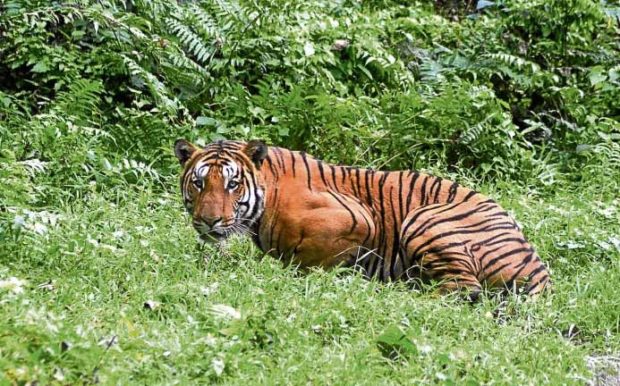
‘SHOCKING TRUTH’ Between 1970 and 2014, wildlife populations representing more than 4,000 species fell by an average of 60 percent. The “shocking truth” is that the wildlife crash is continuing unabated, says Mike Barrett, executive director of WWF. —AFP
Humanity has wiped out 60 percent of mammals, birds, fish and reptiles since 1970, leading the world’s foremost experts to warn that the annihilation of wildlife is now an emergency that threatens civilization.
The new estimate of the massacre of wildlife is made in a major report produced by WWF and involving 59 scientists from across the globe, The Guardian reported on Tuesday.
According to the “Living Planet” report, the vast and growing consumption of food and resources by the global population is destroying the web of life, billions of years in the making, upon which human society ultimately depends for clean air, water and everything else.
“We are sleepwalking toward the edge of a cliff,” said Mike Barrett, executive director of science and conservation at WWF.
“If there was a 60-percent decline in the human population, that would be equivalent to emptying North America, South America, Africa, Europe, China and Oceania. That is the scale of what we have done,” Barrett explained.
“This is actually now jeopardizing the future of people. Nature is not a ‘nice to have’—it is our life-support system,” he added.
Johan Rockström, a global sustainability expert at the Potsdam Institute for Climate Impact Research in Germany, said humanity was rapidly running out of time.
“Only by addressing both ecosystems and climate do we stand a chance of safeguarding a stable planet for humanity’s future on Earth,” Rockström said.
6th mass extinction
Many scientists believe the world has begun a sixth mass extinction, the first to be caused by a species — Homo sapiens, according to The Guardian.
Other recent analyses have revealed that humankind has destroyed 83 percent of all mammals and half of plants since the dawn of civilization and that, even if the destruction were to end now, it would take 5-7 million years for the natural world to recover.
The Living Planet Index, produced for WWF by the Zoological Society of London, uses data on 16,704 populations of mammals, birds, fish, reptiles and amphibians, representing more than 4,000 species, to track the decline of wildlife.
Between 1970 and 2014, the latest data available, wildlife populations fell by an average of 60 percent. Four years ago, the decline was 52 percent.
The “shocking truth” is that the wildlife crash is continuing unabated, Barrett said.
Wildlife and the ecosystems are vital to human life, according to Bob Watson, chair of an intergovernmental panel on biodiversity that said in March that the destruction of nature was as dangerous as climate change.
“Nature contributes to human well-being culturally and spiritually, as well as through the critical production of food, clean water, and energy, and through regulating the Earth’s climate, pollution, pollination and floods,” Watson said.
Causes
“The Living Planet report clearly demonstrates that human activities are destroying nature at an unacceptable rate, threatening the well-being of current and future generations,” he added.
The biggest cause of wildlife losses is the destruction of natural habitats, much of it to create farmland.
Three-quarters of all land on Earth is now significantly affected by human activities.
Killing for food is the next biggest cause—300 mammal species are being eaten into extinction—while the oceans are massively overfished, with more than half now being industrially fished.
Chemical pollution is also significant: Half the world’s killer whale populations are now doomed to die from PCB contamination.
Global trade introduces invasive species and disease, with amphibians decimated by a fungal disease thought to be spread by the pet trade.
Worst affected region
The worst affected region is South and Central America, which has seen an 89-percent drop in vertebrate populations, largely driven by the felling of vast areas of wildlife-rich forest.
In the tropical savannah called cerrado, an area the size of Greater London is cleared every two months, Barrett said.
“It is a classic example of where the disappearance is the result of our own consumption, because the deforestation is being driven by ever expanding agriculture producing soy, which is being exported to countries … to feed pigs and chickens,” he added.
Rivers, lakes
The habitats suffering the greatest damage are rivers and lakes, where wildlife populations have fallen 83 percent, due to the enormous thirst of agriculture and the large number of dams.
“Again there is this direct link between the food system and the depletion of wildlife,” Barrett said.
Eating less meat is an essential part of reversing losses, he added.
WWF director general Marco Lambertini said to forge a “deal for nature,” people could look to climate change for inspiration.
“Two things were crucial for the Paris Agreement. One was the realization that a changing climate was dangerous for the economy and society, not just polar bears. We need to show the risks for us, for humans, of losing nature,” Lambertini told Agence France-Presse (AFP).
Countries are working toward a crunch meeting of the UN Convention on Biological Diversity in 2020, when new commitments for the protection of nature will be made. —With a report from AFP